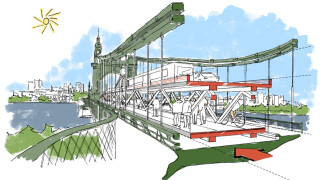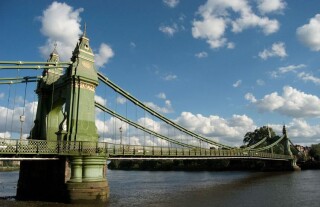A decision to lodge a planning application for the double-decker temporary truss solution was among a £5m package of measures agreed by Hammersmith & Fulham’s cabinet this week.
Planning will require consultation with stakeholders including Historic England, the Environment Agency, Port of London Authority, neighbouring Richmond Council and the Marine Management Organisation.
The double-decking proposal came from architect Foster & Partners working with consulting engineer Cowi. It has been adopted as the council’s preferred option for the full repair of the bridge and its re-opening to motor vehicles.
If approved, it would see a temporary double-decker crossing placed within the existing structure of Grade II*-listed Hammersmith Bridge and supported by the bridge’s foundations. This would enable the bridge to reopen to motorists earlier than the existing Transport for London plan.
The historic 253-metre-long suspension bridge, which crosses the River Thames in west London, was designed by the Sir Joseph Bazalgette and opened to traffic in 1887.
The bridge closed to motor traffic in 2019 and to all traffic in 2020 because of concerns about cracking in the infrastructure. The council reopened the bridge to foot, cycle and river traffic in July 2021 after engineers advised that it was safe to do so but it remains closed to motor vehicles.
Elements of the bridge that need repair, including the decking, would be lifted away using the temporary bridge as a works platform and transported by barges to an off-site facility for safer and easier repair and restoration.


Other works required to move to the next stage are the diversion of two gas mains that currently cross the bridge and further development of the contract and procurement of the full restoration so it is ready to progress when the preliminary stabilisation work is completed.
Cllr Sharon Holder, Hammersmith & Fulham Council cabinet member for public realm, said: “Once again to expedite the full restoration works at pace, we will fund in good faith and at risk the £5m rather than wait for the Department for Transport and TfL’s governance processes to sign off on their one-third shares. We, of course, anticipate that their shares will be subsequently reimbursed.”
FM Conway, with subcontractors Freyssinet and Taziker Industrial began stabilisation works on the bridge in February this year. [See our previous report here.]
Originally expected to take nine months, these works are now due to finish by the end of February, following a delay acquiring steel from Ukraine due to the war. However, the delay has had no impact on the programme for the full restoration as works continue to run in tandem, the council said.
In a separate procurement strategy report, also agreed by the cabinet meeting on Monday 10th October, the council sets out its intention to appoint a private sector contractor to design, renovate, finance and maintain the bridge. The council’s construction costs and the ongoing operation and maintenance of the bridge would be funded by tolls.
Got a story? Email news@theconstructionindex.co.uk




